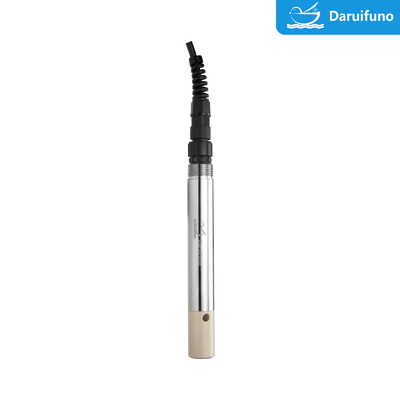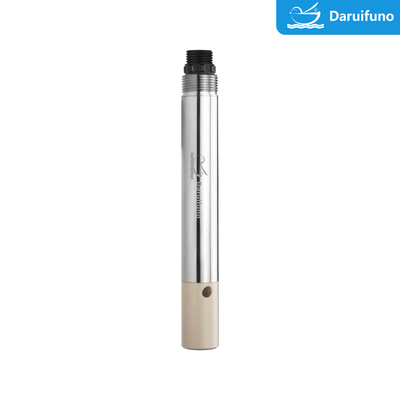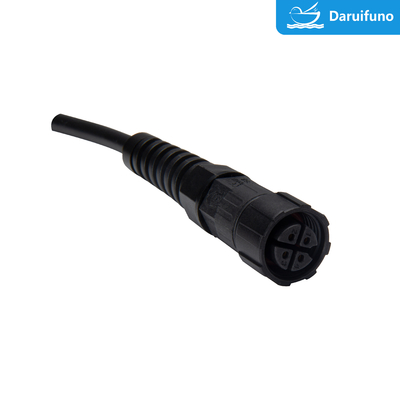High Measuring Range Four Electrode Conductivity Sensor Can Bear Sea Water
The four-electrode conductivity sensor DEC351 is made of titanium alloy, a metal material with good corrosion resistance, so DEC351 usually has good seawater resistance. Even for materials with good seawater resistance, corrosion or oxidation may still occur when exposed to seawater for a long time. In order to ensure the performance and life of the sensor, it is recommended to maintain and clean the sensor regularly, and to use and maintain it according to the manufacturer's recommendations and instructions.
The four-electrode DEC351 conductivity sensor uses a four-electrode structure, and the four-electrode conductivity sensor uses four electrodes for measurement, usually two pairs of electrodes. Of the two pairs of electrodes, one pair is used to transmit current and the other pair is used to measure voltage. This structure can reduce the influence of polarization and external interference, and improve the stability and accuracy of measurement.
The measuring and transmitting electrodes of the sensor are independent, and the conductivity is calculated by measuring the voltage difference. In this way, the influence of electrolyte resistance can be eliminated, the influence of external interference on the measurement can be reduced, and the measurement accuracy can be improved.
The sensor is equipped with digital output, which can be directly connected with digital equipment and control system to realize high-precision data transmission and processing.
The four-electrode conductivity sensor DEC351 has significant advantages in high conductivity samples and a wide measurement range. Its strong anti-polarization performance and high-precision measurement make it the sensor of choice for many high-demand conductivity measurement scenarios.
Specification:
| Model |
DEC350 |
DEC351 |
| Measuring Object |
Salinity |
Conductivity |
| Measuring Principle |
4-electrode |
| Measuring Range |
Salinity: 0~80ppt (‰)
Temp: 0~50℃
|
Conductivity: 0~100 mS/cm
Temp: 0~50℃
|
| Resolution |
0.01% |
0.1uS/cm |
| Accuracy |
±1%FS |
±1% FS |
| Response Time |
T90<15s |
| Temp Compensation |
Automatic, built-in temp unit |
| Digital Output |
RS485, Modbus |
| Calibration Method |
contrast bias correction; factor correction |
| Sample Flow Rate |
Not dependent |
| Work Pressure |
≤6Bar |
| Work Temperature |
0.0~50.0℃ (does not freeze) |
| Storage Temp |
-10~60℃ |
| Shell Material |
Ti+PEEK+Nickel |
| Dimension |
Diameter: 23mm Length: 180mm |
Diameter: 23mm Length: 180mm |
| Installation |
Submersible; Thread specifications: M22*1.5mm |
| Lead interface |
M16 |
| Protection Grade |
IP68 |
| Power Supply |
6~12V DC |
| Weight |
105g |
| Cable |
Standard 5 meters(customized) |
| Power Consumption |
0.2W |
Please click the user manual of RS485 EC sensor here:
DEC351 Conductivity Sensor Manual.pdf
Features& Advantages
- Protection grade IP68, can work continuously under water for a long time
- Standard Modbus protocol, support access to standard industrial control system
- No polarization, can be used continuously online
- Extremely wide range, wider application
- Very resistant to pollution, strong anti-interference ability
- Stable measurement and higher accuracy
- Strong and durable structure, longer service life

Aplication:
Four-electrode conductivity sensors are widely used in various environments, especially those that need to measure high conductivity samples or require high measurement accuracy. Here are some common application environments:
Industrial process control: Four-electrode conductivity sensors are widely used in industrial production processes. It can be used to monitor and control dissolved solids, dissolved salts, ion content, etc. in liquids to ensure the stability and consistency of the production process. It is especially suitable for industrial production of high-concentration brine or other high-conductivity liquids.
Environmental Monitoring: Four-electrode conductivity sensors also play an important role in environmental monitoring. It can be used to measure the salt content in soil, the salinity of water bodies, and other conductivity indicators related to environmental pollution.
Food and beverage production: In food processing and beverage production, four-electrode conductivity sensors can be used to monitor the salinity, concentration and salt content of liquids to ensure product quality and consistency.
Chemical laboratory: In the chemical laboratory, the four-electrode conductivity sensor can be used to measure the conductivity of high-concentration chemical reagents and samples, which is especially important for some specific experiments and research.
Swimming pools and spas: In swimming pools and spas, four-electrode conductivity sensors are used to monitor the chemical balance and water quality of the water body to ensure safe and clean water quality.
Greenhouses and agriculture: Four-electrode conductivity sensors can be used to monitor the conductivity of hydroponic fluids in greenhouses, helping farmers control nutrient supply to plants and improve plant growth efficiency.
In general, the high anti-polarization performance and accurate measurement of the four-electrode conductivity sensor make it suitable for the measurement of high conductivity and high concentration samples, covering various fields from industrial production to environmental monitoring, food processing, chemical laboratories, etc. field needs.
FAQ
Q1. What is the measuring principle of the conductivity sensor?
A: Conductivity cell 4-electrode
Q2. Can this conductivity controller display the resistivity, TDS and salinity of water?
A: Our controller can display the conductivity, resistivity, TDS and salinity of water. Because there is a relationship between these quantities.

 Your message must be between 20-3,000 characters!
Your message must be between 20-3,000 characters! Please check your E-mail!
Please check your E-mail!  Your message must be between 20-3,000 characters!
Your message must be between 20-3,000 characters! Please check your E-mail!
Please check your E-mail! 








